By Thomas Neuburger. Originally published at God’s Spies.
Analyses of the recent historic Democratic loss are thick on the ground. Some provide data or forensic analysis and some prescribe, giving recipes for what to do differently.
Before I delve into forensics of my own, I’d like to offer material from other quarters for your consideration. Consider this a mosaic of what’s being said. What do you think this adds up to?
I’ll offer my own take soon, this week or next.
What the Party Expected Long Term
To understand what happened this week, I think we need to start here. This chart is from a 2020 Center for American Progress (CAP) report titled “America’s Electoral Future: The Coming Generational Transformation”. It claims to show the “full generation effect” on voting for the next few cycles in selected states. Note the slow but inevitable march to the sea — in this case, the warm embrace of the Party in blue.
Note the highlighted projection for 2024. (2020 is shown as a projection because the study was published before that year’s election. Of the states CAP projected to turn blue in 2020, all but Florida did.)
The youth vote was supposed to be a very large part of this move, but as the population shifted, almost all segments were supposed to turn blue eventually.
What Actually Happened: Voter Segments
The actual results were drastically different this time. Let’s start with voter segments.
Youth Realignment
With the CAP report in mind, consider this from The Circle at Tufts University, which studies the youth vote:
According to CIRCLE analyses of the AP VoteCast Survey, nationally 52% of youth voted for Vice President Harris and 46% of youth voted for President Trump. …[I]n 2020 [Trump] received 36% of votes from 18- to 29-year-old voters.
Democratic youth vote collapsed by nearly 20% of its 2020 amount. Here’s what that looks like by gender, 2024 vs 2020:
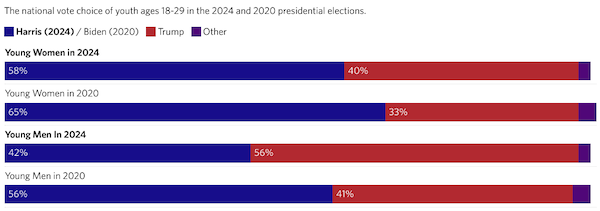
Go back to the CAP projection above. Of the states projected to turn blue in 2024 — Michigan, Pennsylvania, Wisconsin, Florida, Arizona, Georgia, North Carolina — none did. Arizona, which has yet been called, is leaning toward Trump.
Income Realignment
Exit polls show income realignment. In 2020, all income groups except the reasonable well off (those making more than $100,000 per year) favored Democrats by a lot.
All of that changed in 2024. Both low and middle income groups now support Republicans, while the well off now support Dems. The margins are smaller, but the switch is unmistakable.
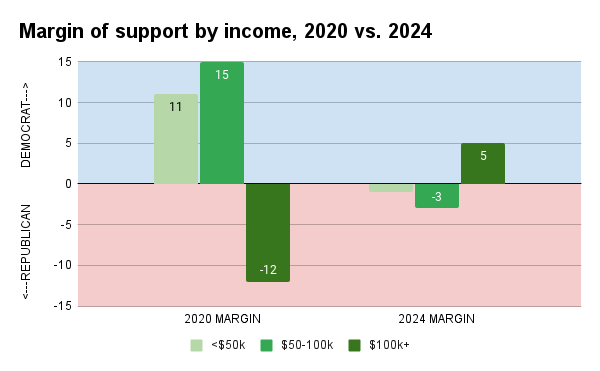
In the main, Democrats most represent the well off.
Race and Ethnicity Shifts
Many have already noted the change in support among racial and ethnicity groups. CNN has done a lot of analysis using the exit polls:
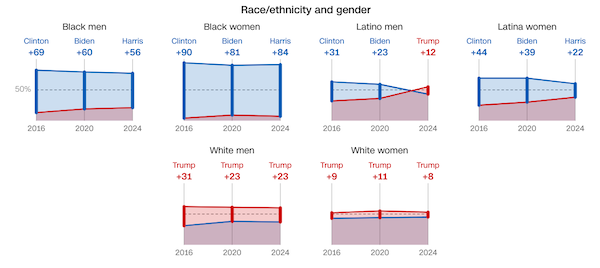
Latino voters, and men in particular, have been moving toward Trump since 2016. This year, Latino men broke in his direction for the first time. Biden won their support by 23 points in 2020 and Trump won them in 2024. Latina women still favored Harris, but by smaller margins than they supported either Clinton or Biden.
Educational Gap Support
From CNN again. Trump’s support among whites with no degree remains strong. Harris lost support among voters of color both with and without degrees.

Harris’s drop from Clinton in 2016 is especially stark.
Economy Voters Broke for Trump
Views on the economy and personal experience of hardship motivated many voters toward Trump. If the economy was your issue, you probably voted for Trump.
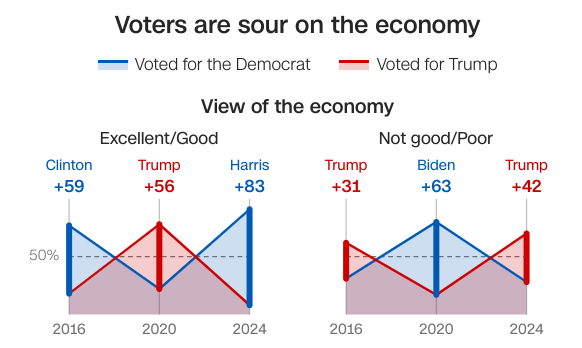
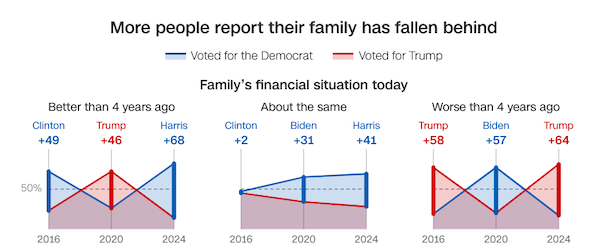
The number of people who thought they were doing worse more than doubled since 2020.
In 2020, just about one-fifth of voters said they were doing worse than four years before. This year, it’s nearly half of voters who say they are doing worse than four years ago. Trump won them overwhelmingly.
One could argue that the first chart is subjective (“views” are always subjective), but the second (“family has fallen behind”) is likely fact-based.
‘Democracy at Stake’
Finally, the “democracy at stake” message worked only with Democrats.
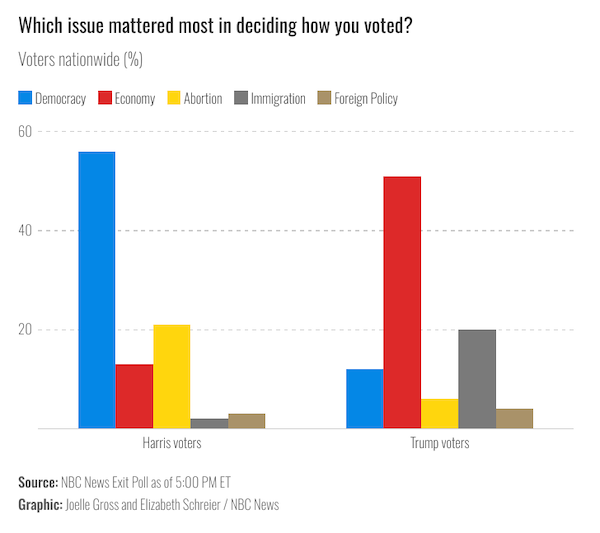
What Actually Happened: The Electorate Everall
Some data from the electorate overall: mixed messages.
Near Universal ‘Red Shift’
Here’s the red shift by county (all voters) as of this writing:
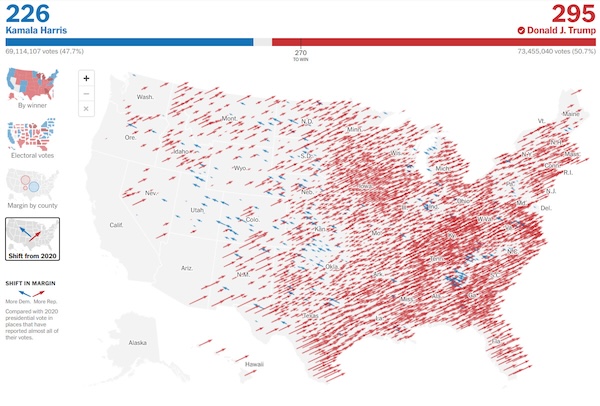
National Popular Vote
Yet with all this shifting toward Trump, the overall national popular vote went down while Trump’s share went up:

Wooing the Republican Party
The Democrats closing strategy seemed to be to grab Republican voters who may not have liked Trump. Here’s how that worked out (hat tip Dave Johnson by email).
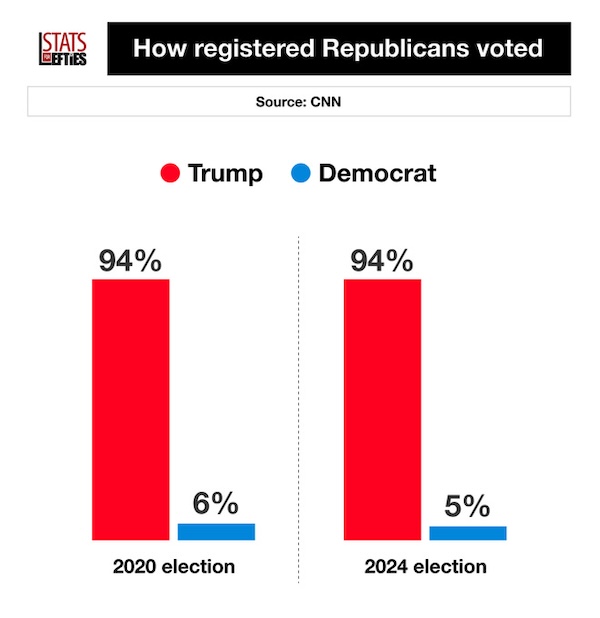
‘Double Haters’ Broke for Trump
In fact, people who hated (“had an unfavorable view of”) both candidates mostly chose Trump over Harris.

I’m among those who didn’t think that would happen.
Analysis: Party Professionals
A number of people close to the Party core — consultants, media mavens and the like — have offered their thoughts.
One of the more notable (and typical) takes is by Morning Joe Scarborough, talking with Rev. Al Sharpton. Bottom line: Racism and sexism doomed the campaign.
[embedded content]
“Blame the electorate” responses are everywhere. Here’s campaign and gun control activist Shannon Watts:
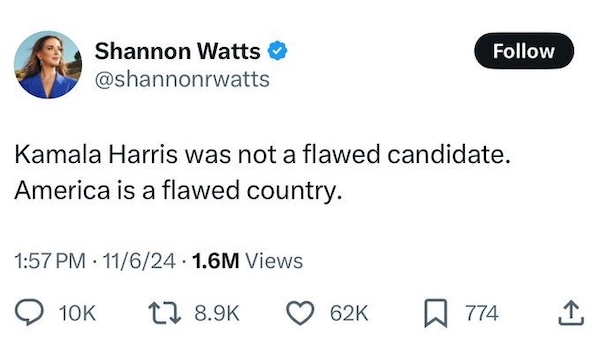
Feminist writer Jill Filipovic:
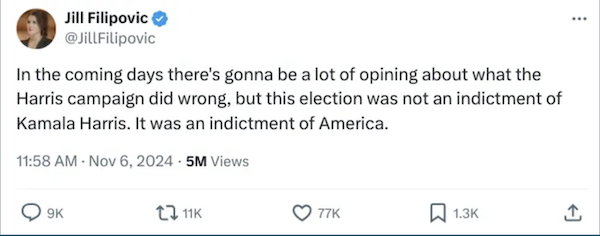
DNC chair Jaime Harrison, countering Bernie Sanders’ pro-populist advice:
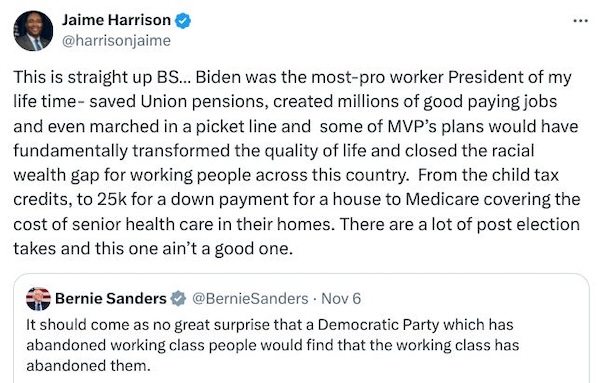
In general, Party leaders and supporters say Harris ran a good campaign. It’s not her fault.
Analysis: Others Weigh In
Others have differing opinions. Economist Pavlina Tcherneva, in a good Twitter thread, notes how many progressive measures passed in Trump-won states.
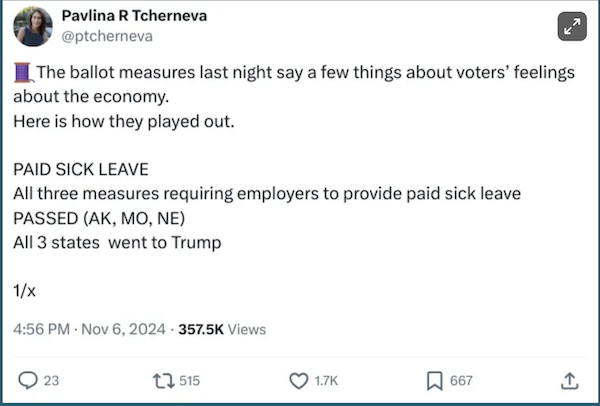
Ian Welsh took a look at abortion reform — ballot measures that supported it and how Harris did in those states:
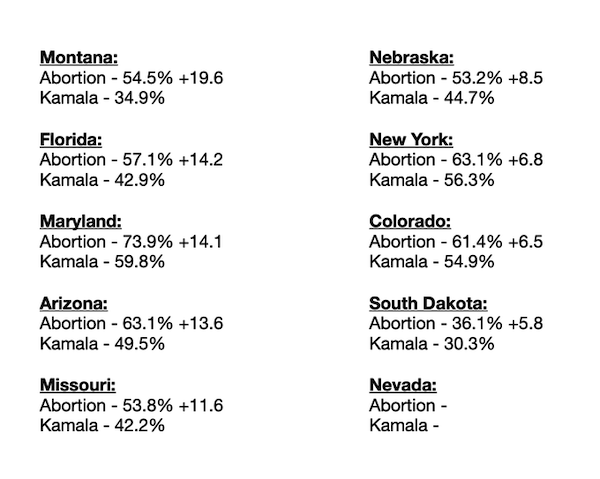
David Sirota thinks Harris’s embrace of the rich had a major damping effect:
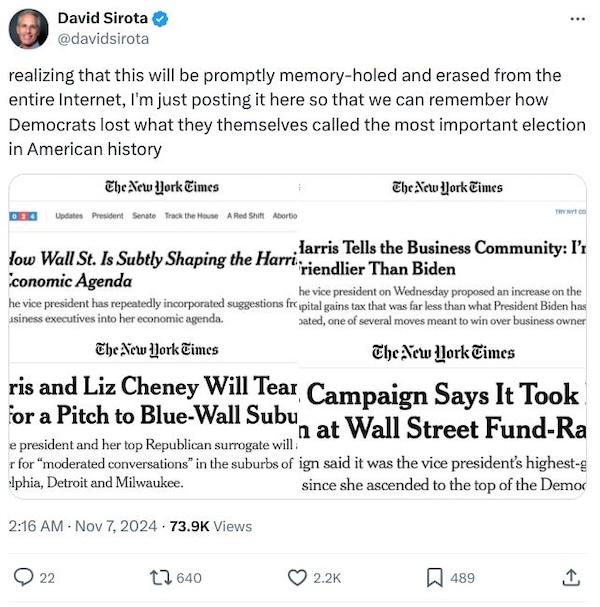
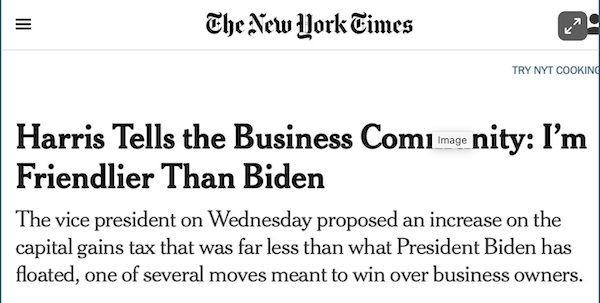
And consider this, from the late David Graeber on the sin of “radical centrism”. He claims Obama, and by extension most of the Party, is guilty (hat tip Double Down News).
[embedded content]
Food for thought, yes? Probably more than a meal’s worth.
Music
Why not? Some may remember this one on the problem of choosing.
[embedded content]


